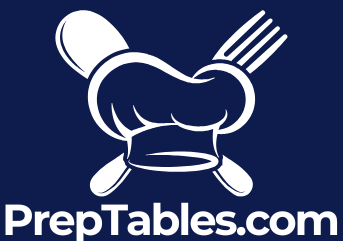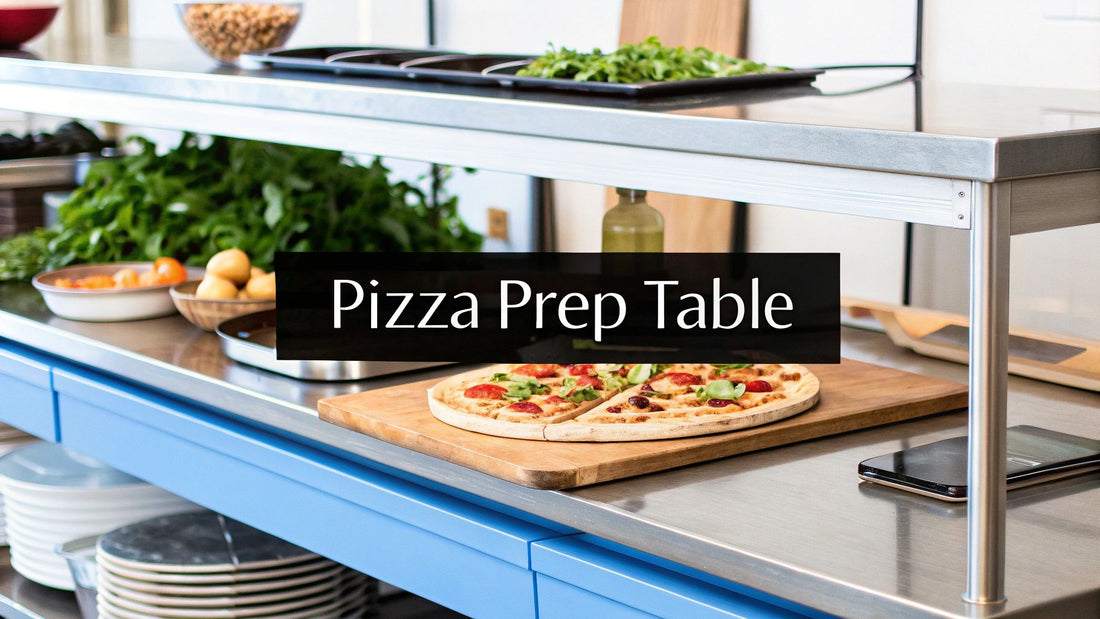
Choosing Your Commercial Pizza Prep Table
Share
A commercial pizza prep table is a specialized, refrigerated workstation built to make the pizza-making process fast, safe, and consistent. It's an all-in-one unit that combines a refrigerated topping rail, a large cutting board, and undercounter cold storage, making it the heart and soul of any serious pizzeria.
The Heart of Your Pizzeria's Workflow
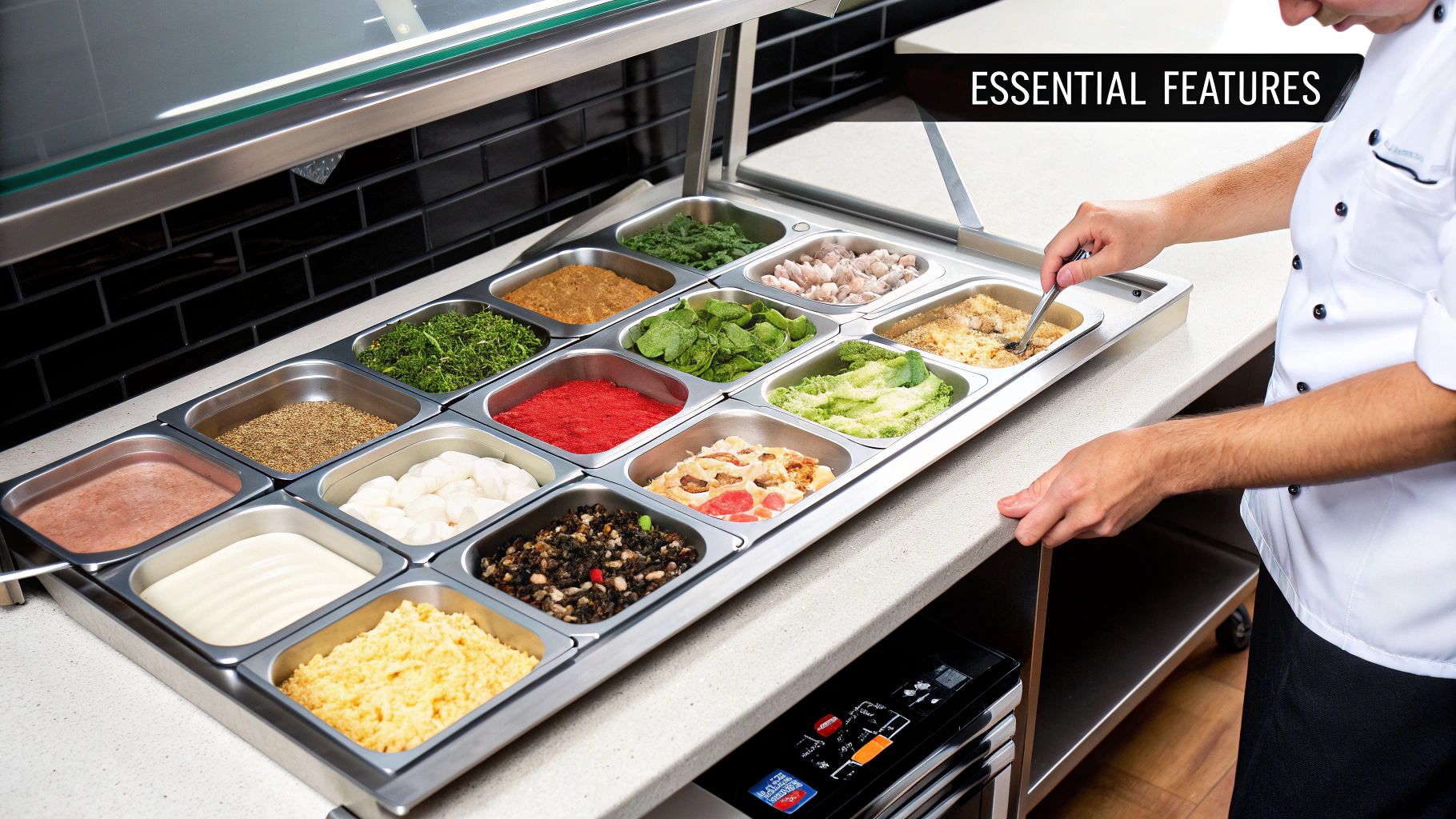
Don't think of a pizza prep table as just another piece of kitchen furniture. It’s the command center for your entire operation. This is where the magic happens—where efficiency, food safety, and consistency come together to create the perfect pizza, every single time. It's an integrated station engineered to smooth out every step of the pizza-building process.
By packing three critical functions into a single footprint, this piece of equipment completely changes the game for your kitchen's workflow. It keeps every topping—from pepperoni and mushrooms to different cheeses and sauces—perfectly chilled and within arm's reach. This smart layout gets rid of wasted steps, slashes prep times, and lets your team build pizzas with lightning speed, even during the craziest dinner rush.
Understanding the Core Components
A real commercial pizza prep table isn't just a cold box with a top. Every part is there for a reason, designed to boost productivity and keep your food top-quality. The three main components work together seamlessly:
- Refrigerated Topping Rail: This is where you keep your pans of prepped ingredients, all held at safe temperatures. The rail is built to keep everything between 33°F and 41°F, which stops bacteria from growing and locks in freshness.
- Spacious Prep Surface: A deep, durable cutting board, usually made from high-density polyethylene, gives you plenty of room to stretch dough, spread sauce, and assemble even the biggest pies without feeling boxed in.
- Undercounter Cold Storage: The refrigerated cabinet underneath gives you bulk storage for backup ingredients, extra dough boxes, and other essentials. This keeps your station fully stocked and cuts down on trips to the walk-in cooler.
This intelligent design is exactly why a dedicated commercial pizza prep table is a must-have for any pizzeria that means business. It's built to handle the unique challenges of making pizza in a way that generic work tables or other prep stations just can't match.
Before we dive deeper, let's quickly recap the main advantages a specialized prep table brings to your kitchen.
Core Benefits of a Commercial Pizza Prep Table at a Glance
| Benefit | Impact on Kitchen Operations |
|---|---|
| Increased Efficiency | Keeps all ingredients chilled and within reach, dramatically cutting down on prep time and wasted movement. |
| Improved Food Safety | Maintains consistent, safe temperatures (33°F to 41°F) for toppings, reducing spoilage and health risks. |
| Enhanced Consistency | An organized station helps staff build every pizza to the same standard, ensuring customer satisfaction. |
| Space Optimization | Combines three essential functions (prep surface, topping rail, cold storage) into one compact unit. |
These benefits aren't just minor improvements; they fundamentally change how your kitchen operates for the better, especially during peak hours.
The global market for commercial pizza prep tables hit about USD 1.75 billion in 2024 and is expected to keep growing. This boom is fueled by the worldwide love for fast food and pizza delivery, which pushes more kitchens to get specialized, high-efficiency gear. You can check out the full market analysis on Verified Market Reports.
Ultimately, buying the right table is an investment in your pizzeria's future. It ensures every pizza that goes out your door not only tastes fantastic but is also made safely and efficiently, living up to the high standards your customers expect. It’s the foundation of a smooth, profitable pizza business.
Comparing Different Commercial Prep Tables
Not all commercial prep tables are created equal, and choosing the right one is critical for your kitchen's success. The world of stainless steel prep tables includes a variety of specialized units, each designed for a specific purpose. Thinking a basic work table can do the job of a pizza prep table is like bringing a sedan to a racetrack—it will lead to bottlenecks, food safety risks, and costly mistakes.
The market for these specialized tables is booming. The industry was valued at USD 1.18 billion globally in 2023 and is on track to hit USD 1.62 billion by 2029. This growth shows just how vital the right equipment has become. To ensure you make the best choice, let's break down the main types of stainless steel prep tables available.
The Purpose-Built Commercial Pizza Prep Table
Think of a commercial pizza prep table as the heavyweight champion of prep stations. It’s engineered from the ground up with one goal in mind: to make building pizzas as fast and efficient as humanly possible. Every part of its design reflects the unique demands of a pizzeria.
- Extra-Deep Cutting Board: These tables boast a much wider work surface, usually 16 to 20 inches deep. This generous space isn't a luxury—it's essential for handling large pizza skins. It gives a pizzaiolo room to stretch dough, add sauce, and pile on toppings without everything spilling over the edge.
- Deep Refrigerated Rails: The topping rail is built to hold deep, 1/3-size food pans. This is a game-changer for holding bulky pizza toppings like pepperoni, sausage, and bell peppers, not to mention massive quantities of shredded mozzarella.
It's this combination of a wide workspace and deep topping wells that makes a true pizza prep table indispensable. It’s a specialized tool built for a specific, high-volume job.
Key Takeaway: The design of a pizza prep table directly solves the unique challenges of making pizza. Its wide board and deep wells prevent the workflow killers you’d face on a smaller, less specialized unit.
The Nimble Sandwich and Salad Prep Table
Now, let's look at its close cousin: the sandwich and salad prep table. While it looks similar with its refrigerated rail and cutting board, its design is tailored for completely different needs. It's more like a quick, agile vehicle for smaller, more delicate tasks.
The most obvious difference is the workspace. A sandwich table usually has a much narrower cutting board, typically only 8 to 12 inches deep. This is perfectly fine for putting together a sandwich or tossing a salad, but you’d find it incredibly cramped trying to build a 16-inch pizza on it.
Their refrigerated rails are also designed for shallower, 1/6-size food pans. This setup works great for holding smaller amounts of sliced deli meat, cheese, lettuce, and diced veggies. Trying to cram bulky pizza toppings into these little pans would be a nightmare, forcing your team to constantly stop and refill during a busy rush.
This image really drives home why picking the right size and type of table for your kitchen is so important.
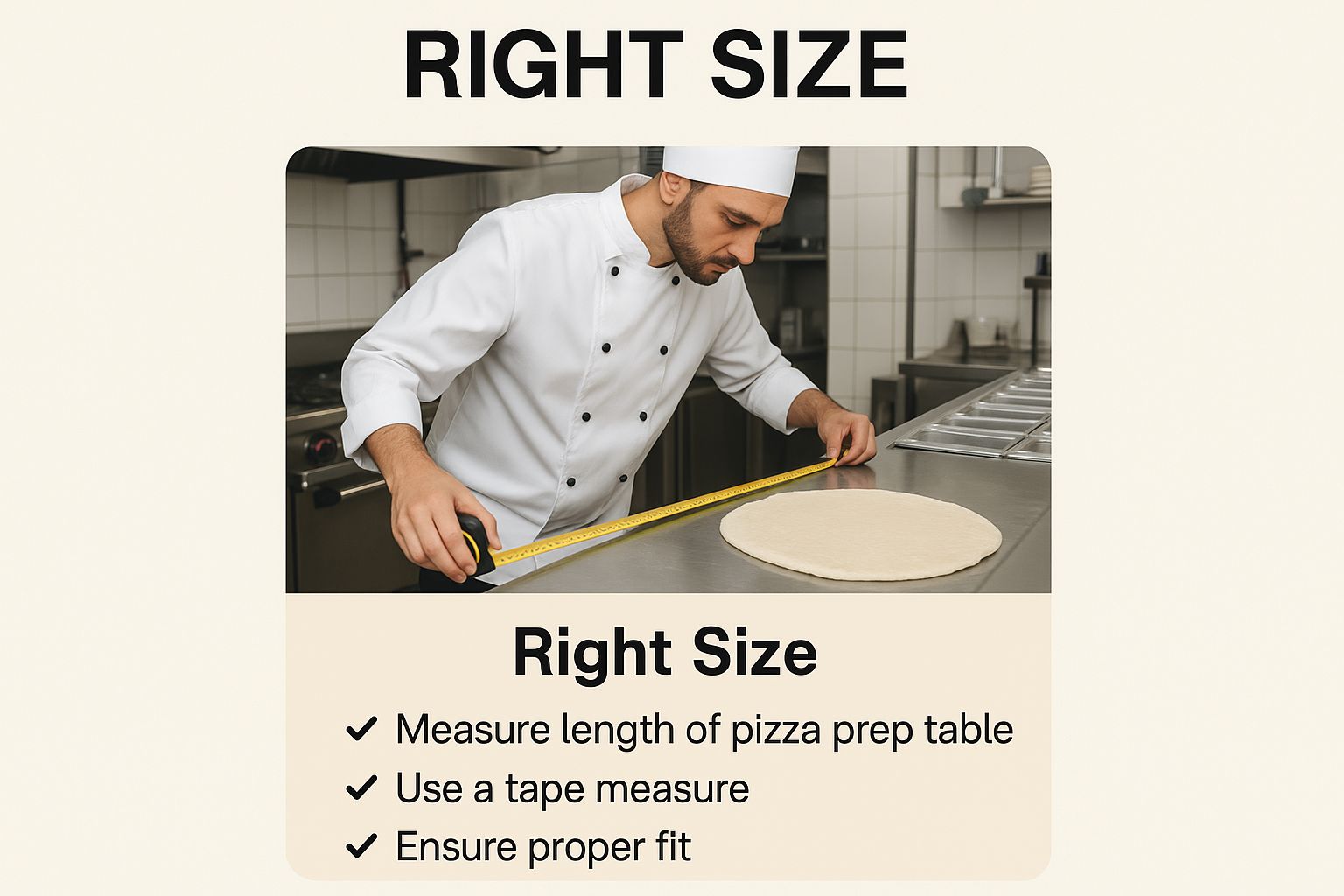
It’s a great reminder that matching the equipment's dimensions to your workflow is one of the first steps in designing an efficient kitchen.
The All-Purpose Stainless Steel Work Table
Finally, we have the simple, classic stainless steel work table. This is the most basic of the three, offering a versatile, flat surface with no built-in refrigeration. You’ll see them used for all sorts of general, non-refrigerated tasks like kneading dough, portioning ingredients, or holding small appliances.
While every kitchen needs one, it can't replace a refrigerated prep station. Imagine your crew trying to assemble pizzas on a standard work table. They’d be running back and forth to a separate fridge for every ingredient, creating huge inefficiencies and opening the door to food safety violations as cold toppings start to warm up. It’s for this exact reason that brands like Atosa offer a whole range of specialized units. You can learn more about how a purpose-built Atosa pizza prep table can solve these workflow headaches.
Ultimately, choosing the right table comes down to matching the equipment to your menu. For any pizzeria, investing in a true commercial pizza prep table isn't a luxury—it's a fundamental requirement for a smooth, safe, and profitable operation.
Decoding the Must-Have Features
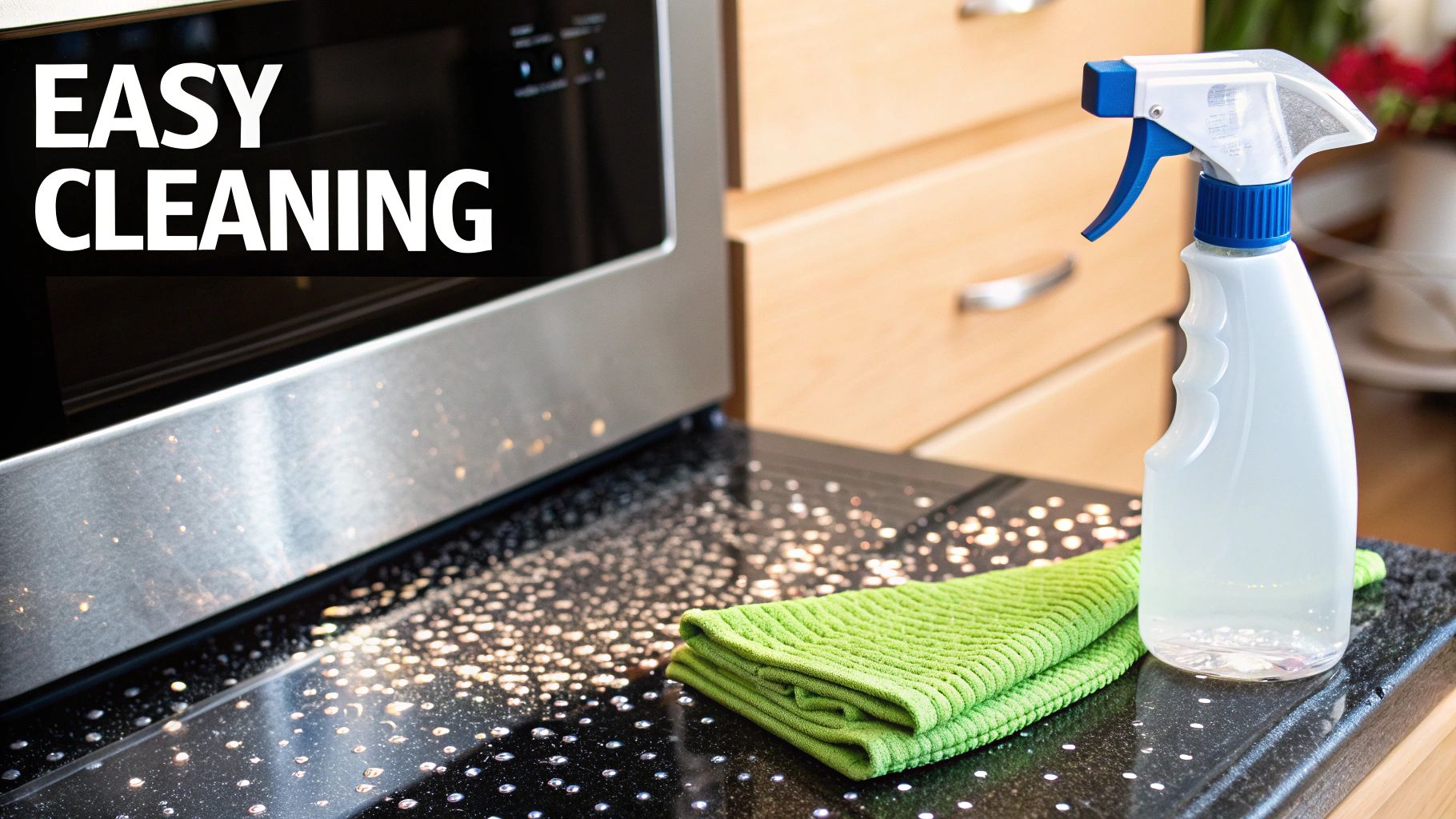
When you're finally ready to invest in a commercial pizza prep table, staring at a spec sheet can feel like trying to read a foreign language. It’s easy to get lost in the details. But picking the right features is about more than just buying equipment—it's an investment in your pizzeria's speed, efficiency, and food safety.
Let's cut through the marketing jargon and translate those technical specs into what they actually mean for your daily grind. Once you understand the core components, you'll be able to spot a high-performance table that's built to last and, most importantly, help you pump out amazing pizzas.
Refrigeration Systems: The Heartbeat of Your Table
The refrigeration system is, without a doubt, the most critical part of your prep table. Its entire job is to keep your precious ingredients out of the temperature "danger zone" (that's 41°F to 135°F), where nasty bacteria can multiply in a heartbeat. You'll generally run into two types of systems out there.
A forced-air refrigeration system is the workhorse. It uses fans to actively push cold air all around the topping rail and the storage base. This is huge because it guarantees a consistent temperature across every single ingredient pan, even when the lid is constantly being opened during a chaotic Friday night rush. For any serious, high-volume pizzeria, this is the way to go.
On the other hand, you have cold-wall systems, which cool the unit with refrigerant lines running through the walls. They’re often quieter and a bit more energy-efficient, but they can be less consistent. You might end up with some pans being colder than others. For a bustling pizza kitchen, the reliability of a forced-air system is almost always worth it.
The Workspace: Cutting Board and Stainless Steel
This is where all the action happens, so your work surface needs to be up to the task. The cutting board on a commercial pizza prep table should be both deep and tough. Look for boards that are at least 16 to 20 inches deep to give your team plenty of room for stretching dough and building large pies without toppings spilling everywhere.
The best cutting boards are made from high-density, NSF-certified polyethylene. This stuff is a kitchen's best friend—it’s non-porous, so it won’t soak up bacteria or smells, and it’s rugged enough to handle constant chopping without destroying your knives.
The table's body should be built from high-quality stainless steel. You'll see different grades mentioned, like 304 and 430. Think of Type 304 stainless steel as the premium choice; its excellent corrosion resistance makes it perfect for the tabletop and any area that touches food. Type 430 is a more budget-friendly grade you’ll often find on the sides and back, where the wear and tear isn't as intense.
Storage and Access: Doors vs. Drawers
Underneath the workspace, you need to decide between doors or drawers for your cold storage. This choice really comes down to your kitchen's workflow.
- Doors are the classic option. They give you a wide-open storage cavity that’s perfect for bulky items like big bags of cheese or dough boxes. They’re also typically more affordable and simpler to clean out.
- Drawers are all about organization and speed. They offer incredible, ergonomic access to smaller, pre-portioned ingredients. Your staff can just pull open a drawer and grab what they need without bending over and digging through a cabinet.
For many busy kitchens, a combination unit with both doors and drawers offers the best of both worlds. If you want to explore how different setups work, you can learn more about all kinds of commercial refrigerated prep tables to find what fits your space.
Finally, don't overlook the raised rail lid. This insulated cover is non-negotiable. It doesn’t just help keep your toppings at a consistent, safe temperature; it also shields them from dust and other airborne contaminants when the table isn't in use. It's a simple feature that's absolutely vital for food safety and cutting down on waste.
Finding the Perfect Size and Fit
The right commercial pizza prep table should feel like a natural extension of your kitchen, not a bulky obstacle course. Picking the perfect size isn't just about what fits in the room; it’s about matching the equipment to the very soul of your pizzeria—your daily pizza output, the complexity of your menu, and the actual floor space you have.
Think of it like this: you wouldn't use a tiny socket wrench to change a truck tire, nor would you bring a giant industrial wrench to fix a watch. A prep table that’s too small will create instant bottlenecks on a busy night. One that's too big just eats up valuable space and energy.
Matching Table Size to Your Pizza Volume
First things first, you need to be honest about your output. How many pies fly out the door on a slow Tuesday compared to a slammed Friday night? That number is your starting point for figuring out the table width you need. Common sizes run from compact 48-inch models all the way up to 93-inch workhorses.
- Small Pizzerias & Food Trucks (44 to 48-inch tables): These are the go-to for tight kitchens or places with a focused, simple menu. They'll typically hold about six 1/3-size pans, which is plenty for your essential toppings.
- Medium-Volume Restaurants (60 to 72-inch tables): This is the sweet spot for a lot of pizzerias. They give one or two pizzaiolos enough elbow room and can hold nine or more pans, letting you offer a more diverse topping selection.
- High-Volume Operations (90-inch and larger tables): For kitchens that never stop, these massive tables are non-negotiable. They can easily fit multiple chefs working shoulder-to-shoulder and have the pan capacity for a massive list of ingredients.
It’s a useful stat to keep in mind: 93% of Americans eat pizza at least once a month. Having the right size equipment to handle that demand is what keeps your kitchen humming and your customers happy during those peak hours.
Choosing the right size is a direct reflection of your business's scale and ambition. A well-chosen table prevents chaos and keeps the pizza line moving smoothly.
Here’s a simple breakdown to help you visualize what size might work for you:
Pizza Prep Table Size vs. Operational Capacity
| Table Width | Typical Pan Capacity (1/3 size) | Ideal For (Business Scale) |
|---|---|---|
| 44-inch to 48-inch | 6 to 9 Pans | Small pizzerias, food trucks, or cafes with a limited pizza menu. |
| 60-inch to 72-inch | 9 to 12 Pans | Medium to high-volume pizzerias that require a wide variety of toppings. |
| 90-inch to 93-inch | 12+ Pans | High-volume pizzerias, large chains, or institutional kitchens with multiple chefs. |
Matching the table width to your operational capacity ensures you have what you need without overspending or wasting precious kitchen real estate.
The Storage Showdown: Doors vs. Drawers
Underneath the cutting board and topping rail lies another huge decision that directly impacts your workflow: the refrigerated storage. You’ve basically got two choices, and each one is built for a different kind of kitchen rhythm.
Doors give you flexible, wide-open storage space. This setup is perfect for stashing bulky items that are crucial for making pizzas but don't fit neatly into small pans. We're talking big boxes of dough, giant bags of shredded mozzarella, or backup tubs of sauce. Generally, this is the more budget-friendly option.
Drawers, on the other hand, are all about speed and organization. They offer immediate, easy access to pre-portioned ingredients like sliced pepperoni, veggies, or different cheeses. Instead of a chef bending down and digging through a cabinet, they can just slide open a drawer and grab what they need. It’s a small change that eliminates a ton of wasted motion.
For a deeper look into how different workstation layouts can support your kitchen, you can check out the various types of stainless prep tables.
In the end, the best setup often isn't an "either/or" choice. Many kitchens discover that a combination unit—with doors for bulk storage and drawers for quick-grab items—creates the most balanced and efficient workflow, helping keep things from getting out of control during the dinner rush.
Essential Maintenance and Cleaning Routines
Think of your commercial pizza prep table as a serious investment in your kitchen's speed and safety. Just like any high-performance piece of equipment, it needs regular care to keep running at its best. Ignoring maintenance is more than just risky—it's a surefire way to rack up costs. A neglected unit can mean failed health inspections, expensive emergency repairs, and spoiled food that cuts right into your profits.
These routines aren't chores; they're insurance for your investment. By weaving these simple habits into your kitchen's daily flow, you can make sure your prep table stays a reliable workhorse instead of a ticking time bomb. Let's walk through the daily, weekly, and monthly tasks that will protect your gear and your bottom line.
Daily Cleaning Habits for Food Safety
These quick jobs, done at the end of every shift, are your first line of defense against bacteria and cross-contamination. They only take a few minutes but are absolutely essential for a clean and safe workspace.
- Sanitize All Food-Contact Surfaces: This means the cutting board, the entire topping rail, and all the pan lids. Clear off any food bits, wash with soap and water, rinse well, and then use a food-safe sanitizer exactly as the instructions say.
- Wipe Down Exterior Surfaces: Grab a clean cloth and wipe down the stainless steel exterior, door handles, and control panels. This gets rid of fingerprints, spills, and grease.
- Empty and Clean Ingredient Pans: When the day is done, all leftover ingredients need to be stored properly. The pans themselves should be washed, rinsed, and sanitized so they’re fresh and ready for the next day.
These simple steps stop grime and germs from building up, ensuring every pizza you make starts on a clean slate.
Crucial Insight: There's a reason health codes require the topping rail to stay between 33°F and 41°F. Daily cleaning helps your unit hold that temperature without struggling, which is critical for keeping harmful pathogens off your ingredients.
Weekly Deep-Cleaning and Inspection
Once a week, it's time to dig a bit deeper. These tasks hit the spots that don't need daily attention but are still vital for your table's health and performance down the road.
- Remove and Deep-Clean the Cutting Board: If your cutting board is removable, pull it out and give it a good scrub. You want to get rid of any deep-set stains or food particles. This is also the perfect time to check for deep cuts or gouges where bacteria love to hide.
- Clean Inside the Storage Cabinet: Empty out the refrigerated base completely. Wipe down all the interior walls, shelves, and the floor of the cabinet with a food-safe cleaner to get rid of any spills that have collected over the week.
- Inspect and Wipe Down Gaskets: The rubber seals around the doors and lids are key to keeping the cold in. Wipe them down and look for any cracks, tears, or signs of mold. A bad gasket makes the compressor work overtime, which wastes energy and leads to an early breakdown.
Monthly Mechanical Maintenance Checks
These monthly checks are less about scrubbing and more about preventative care for the heart of your prep table: the refrigeration system. Spending a few minutes on this can save you from a multi-thousand-dollar emergency repair call.
The single most important monthly task is cleaning the condenser coil. This part is what pushes heat out of the system. Over time, it gets clogged with a mix of dust, grease, and flour, which acts like a blanket and insulates it. This forces the compressor to run nonstop and is a top reason why refrigeration units fail.
To clean it, first unplug the unit. Find the coil—it's usually behind a grille on the front or side—and use a stiff brush or a vacuum to gently clear all the gunk from the fins. This one simple action makes a huge difference in efficiency and can dramatically extend the life of your compressor. Following this routine will keep your commercial pizza prep table running at its peak for years.
Common Questions About Pizza Prep Tables
When you’re in the market for a commercial pizza prep table, a lot of practical questions pop up. Once you get past the basic specs and features, you start wondering how the unit will actually hold up in the heat of service.
This section tackles those common questions head-on. We'll give you clear, straightforward answers to help you choose, use, and maintain your equipment like a seasoned pro.
What Is the Real Difference Between a Pizza Table and a Sandwich Table?
At a quick glance, pizza and sandwich prep tables look like they could be twins. But they’re actually built for completely different jobs, and thinking they’re interchangeable is a classic mistake. The two biggest giveaways are the cutting board depth and the refrigerated rail design.
A true commercial pizza prep table comes with an extra-deep cutting board, usually 16 to 20 inches from front to back. That generous space is non-negotiable for handling large pizza skins, giving your crew plenty of room to stretch dough, slop on sauce, and load up toppings without making a huge mess.
Its refrigerated topping rail is also built differently, designed to hold deep, 1/3-size food pans. This is a must for bulky pizza ingredients like pepperoni, sausage, and mountains of mozzarella. More capacity means fewer frantic refills during a chaotic dinner rush.
A sandwich or salad prep table, in contrast, has a much skinnier cutting board, typically just 8 to 12 inches deep. That’s perfectly fine for slapping together a sub or a salad, but you’ll feel boxed in trying to make a pizza on it. The rail is also designed for shallower, 1/6-size pans, which work for deli meats or diced veggies but are totally impractical for the high-volume toppings a pizzeria burns through.
Are Drawers Worth the Extra Cost Over Doors?
This is the age-old debate, and the honest answer is: it depends on your kitchen’s workflow. Drawers almost always cost more than doors, but for many pizzerias, that extra cash is a smart investment in speed and organization.
Drawers give you fantastic ergonomic access to your ingredients. Instead of bending over and digging through a cabinet, your staff can just slide a drawer open and see everything neatly portioned and ready to go. This shaves precious seconds off every single order, which really adds up during a slammed shift. They’re perfect for storing sliced meats, cheeses, and prepped vegetables.
Doors, on the other hand, are the budget-friendly option and give you unmatched flexibility for bulk storage. That open cabinet space is ideal for stashing large, awkward items that just won’t fit in drawers—think dough boxes, big bags of cheese, or backup sauce containers.
For many spots, a combo unit with both doors for bulk goods and drawers for high-use items is the sweet spot, giving you the best of both worlds.
Expert Insight: The choice between doors and drawers directly impacts your kitchen’s speed and ergonomics. Look at your menu and prep process. If your team is constantly grabbing portioned items, drawers will pay for themselves in labor savings and a smoother workflow.
How Do I Clean the Condenser Coil and How Often?
Cleaning the condenser coil is hands-down the most important maintenance task you can do to protect your refrigeration system. A gunked-up coil is the number-one cause of compressor failure, and that’s a repair bill you do not want to see.
The process itself is pretty simple:
- Unplug the Unit: Safety first. Always kill the power before you start any maintenance.
- Locate the Coil: You’ll usually find the condenser coil behind a grille on the back, side, or front of the unit.
- Gently Clean the Fins: Grab a stiff-bristled brush (a dedicated condenser coil brush is best) or a vacuum with a brush attachment. Carefully clean out all the dust, grease, and grime from the coil fins. Make sure you brush in the same direction as the fins to avoid bending them.
You should tackle this job at least once every 90 days. But if your kitchen has a lot of airborne grease or flour, doing it monthly is a much smarter move. A clean coil lets the fridge breathe and get rid of heat efficiently, keeping the compressor from overworking and extending the life of your commercial pizza prep table.
What Is the Ideal Temperature for the Topping Rail?
Your refrigerated topping rail needs to be kept in a very tight temperature range to keep your food safe. According to FDA guidelines, the sweet spot is between 33°F and 41°F (0.5°C to 5°C).
This temperature range is absolutely critical. It keeps perishable ingredients out of the "temperature danger zone" (41°F to 135°F), where bacteria can go wild and multiply. Holding this temperature consistently means your cheese, meats, and veggies stay fresh, safe, and delicious.
Even if your unit has a fancy digital display, it’s a good practice to use a separate, calibrated thermometer to spot-check the temperature inside a few of the pans. This will confirm that cold air is circulating evenly and that every single topping is being held at a safe temp all day long.
Ready to build the heart of your pizzeria? Find the perfect commercial pizza prep table at PrepTables.com, where we offer a wide selection of durable, NSF-certified equipment designed to boost your kitchen's efficiency and food safety. Explore our collection and build a smarter workflow today at https://preptables.com.
